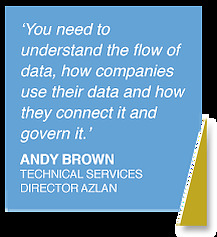As the amount of data available explodes, interest in using business intelligence and analytics tools to extract value from information is growing – we look at how resellers can turn their curiosity into real business.

IT people have been talking about getting more intelligence and useful information out of data for decades. But somehow, they have never found a way of extracting its full value. The ‘holy grail’ of having all systems seamlessly integrated and standardised, with data shared easily and with insightful and meaningful reports and graphs being fed back at frequent intervals has never quite been found.
Data is still by and large stored in disparate silos and any further insights or conclusions must be drawn by managers using their own personal business intelligence.
So why is Business intelligence (BI) and analytics coming to the fore now? According to George Wood, Solutions Architect in TD SYNNEX’s Microsoft team, it’s down to the proliferation of devices and information, the immediacy that social media and interactive web sites provide, and the availability of easy-to-use solutions that make extracting intelligence form data much easier than it’s ever been.
‘We have a huge amount of data now and we want to get insights out of that data – and the technologies that enable us to do that are becoming easier to access and use. Why does BI matter? Number one, it’s the insights you can gather about your customers and your business, and number two, being able to use those insights to make your business more efficient and effective.’
Tidal wave
The advancement of technology, the Internet, the cloud, the availability of mobile devices and easy online access and the tidal wave of data these developments have brought are all contributed to the rise of BI as a trend.
Andy Brown, Technical Services Director for Azlan, said that the availability of cloud-based services is certainly a major contributor. Services providers are using analytics engines to offer ‘as a service’ propositions for specific vertical markets.
‘The technology has developed now to the point where it’s reduced the skills gap [needed to use analytics software] at the lower end and made it more accessible. The rise of software as a service has allowed analytics to be delivered for specific business user cases and verticals.’
As software developers have started offering more advanced BI options, users have become more aware of the possibilities and started looking for more ways to extract value from their data.
Extracting more value
 Another reason BI and analytics is taking off is the emphasis on being smarter with technology, said Brown. ‘In the 80s and 90s companies were focused on having the latest and greatest. More recently, customers have been looking to reduce costs but at the same time maintain their competitive edge.
Another reason BI and analytics is taking off is the emphasis on being smarter with technology, said Brown. ‘In the 80s and 90s companies were focused on having the latest and greatest. More recently, customers have been looking to reduce costs but at the same time maintain their competitive edge.
‘Innovating while saving money is always going to be a challenge – BI enables you to do both. You can get a deeper view of your efficiency and new value out of existing data. You can enhance services and identify new opportunities.’
The Internet itself is one of the reasons that BI and analytics has emerged so strongly. It has allowed organisations to gain access to more information, often in real time, about customer activity and trends. This data can then be combined with their own and analysed. BI and analytics promises to give companies an all-round, 360-degree view of customers, trends, markets – everything that impacts their business.
Strategic or tactical
As a reseller, you do need some knowledge of the subject to sell it, said Brown. ‘There is a skills requirement around analytics. You need to understand the flow of data, how companies use their data and how they connect it and govern it.’
With GDPR coming into play next year, the way data is managed, used and secured is important. And, having realised they can, enterprises want to do more with their data, so their approach tends to be more strategic. Large organisations need to have a standard way of gathering, storing and sharing data, so that it is consistent, compliant and protected – and it can be used readily by BI and analytics engines. The simple quality of data needs to be addressed before it is enriched by adding information from other sources.
Whether it is at a tactical or strategic level, the opportunity is in helping customers to leverage the value of data. Larger organisations will certainly be addressing the issues already, compelled by the need to ensure security and compliance, but in the SMB market, there is broader potential.
‘Mid-market companies and SMBs won’t have people focused on managing data. They will have managers and database admins and people who run reports. But not anyone focused on data. The mid-market will increasingly lean on channel partners to offer guidance and deliver services around data management, delivering insights and having a data strategy.’

Azlan is already helping partners to acquire the knowledge they need. It is working with many of the key vendors in this segment, such as IBM, Informatica, Information Builders, Pentaho, and Microsoft.
‘We understand the market and the technology available’, said Brown. ‘We can help resellers understand what kind of approach might work well. Then how they get involved and accelerate their capability. If necessary, we can help them to fill the gaps in their own skills as they step into these markets.’
TD SYNNEX and Azlan are on a journey into the new and emerging digital economy market, he added, and eager to help resellers make the same transition. ‘We want our partners to be there on that journey with us. There is an inherent value in data and helping customers to get to that value. We have access to a very broad ecosystem of systems and vendors and service delivery organisations and we can help partners access skills they might not have today.’
Enterprise customers are already becoming digitally-driven and are starting to define data strategies. There are opportunities here, but many more lie in enabling mid-market and SMB companies to define the potential that lies within their information and derive more intelligence from it. For every organisation, the ‘holy grail’, the definitive insights that can be drawn out of data, will be different.
They may have been searching for some time, but it’s also likely that many do not even realise that the grail exists. They remain blissfully unaware of the huge potential that lies dormant within their data. BI and analytics may help them realise it is there and set out on a quest to find it.
Read more of our latest stories
